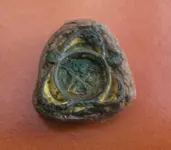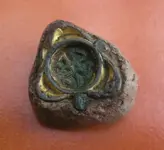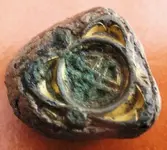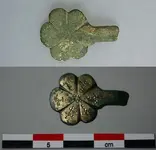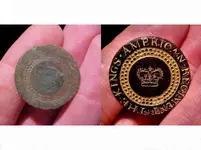Iron Patch said:
Tom_Restorer said:
hi,
this is a real rare find and I woud not use any chemicals on gilded pieces! (this forum seems to be full of wrong chemical technics...)
Try to clean it carefully under a microscope with a scalpel !
This small malachit encrustions are not so hard as they look and easy to remove.
If you are afraid to make scratches with a new scalpel, you can make the blade a little bit blunt with fine sand paper.
Look at the picture. This pieces was cleaned only with a scalpel in approx 30 minutes.
Tom
Well look at this picture, it wasn't cleaned with a scalpel, and is also a rare find. I'll let the picture speak to your comment of wrong techniques.
yes, the picture speaks. I see enough shining copper parts around the legend. The gilded parts are cleean but the patina on the copper is gone or changed dark from chemical effect and i would bet that the gilded parts lies much higher than the remaing copper without the patina. May you be lucky with this result (on such a jung token or coin) but on an 1000 years older piece I wouldn´t try it and a much better result is only to get mechanical.
PS: with chemical cleaning and a little bit unluck, you destroy the cuprit layers under the gilded parts (wich hold it on the piece) and the gold get lost.
You can get the same effect as when you but a gildet piece in a supra sonic bath.
Tom

 my friend found this Viking Trade Weight
my friend found this Viking Trade Weight  it has a Guilded triqueta pendant inlaid in lead. As you can see some of the Guilding has corrosion build up, heavy in places.
it has a Guilded triqueta pendant inlaid in lead. As you can see some of the Guilding has corrosion build up, heavy in places. I know that sometimes the Guilding can be under the corrosion, but as it's a quite rare find the question remains should it be tryed or left alone
I know that sometimes the Guilding can be under the corrosion, but as it's a quite rare find the question remains should it be tryed or left alone 

